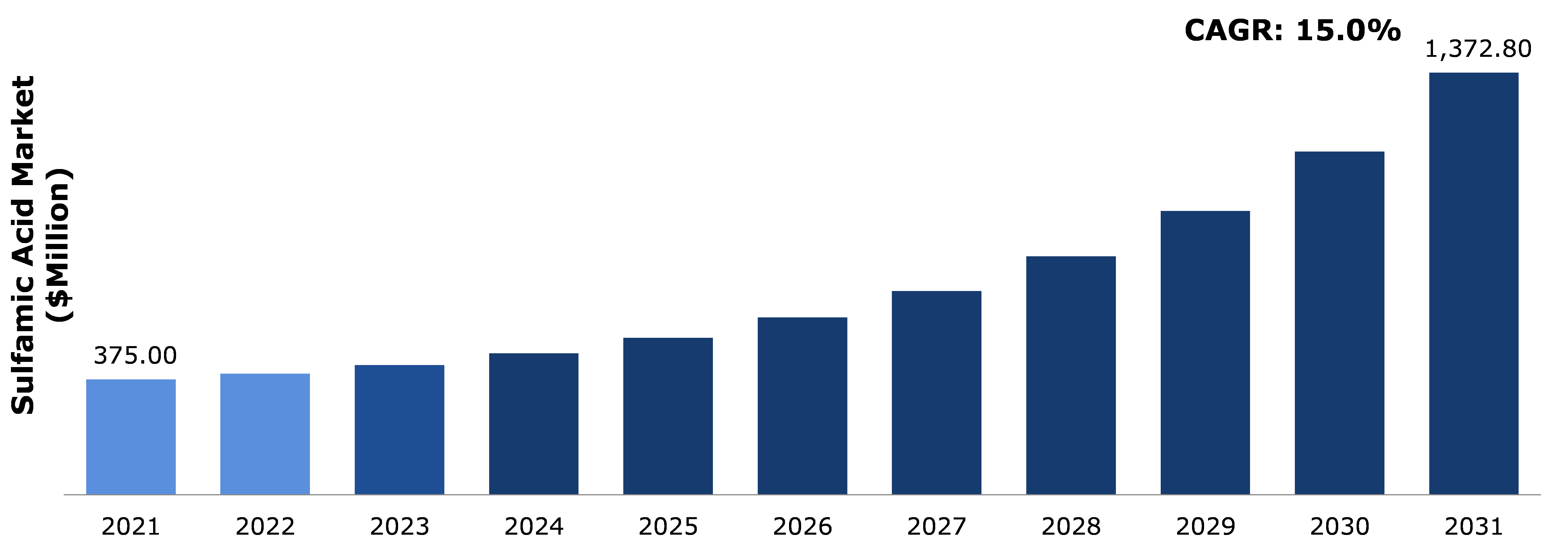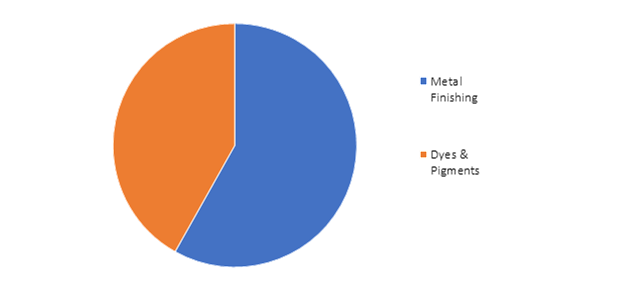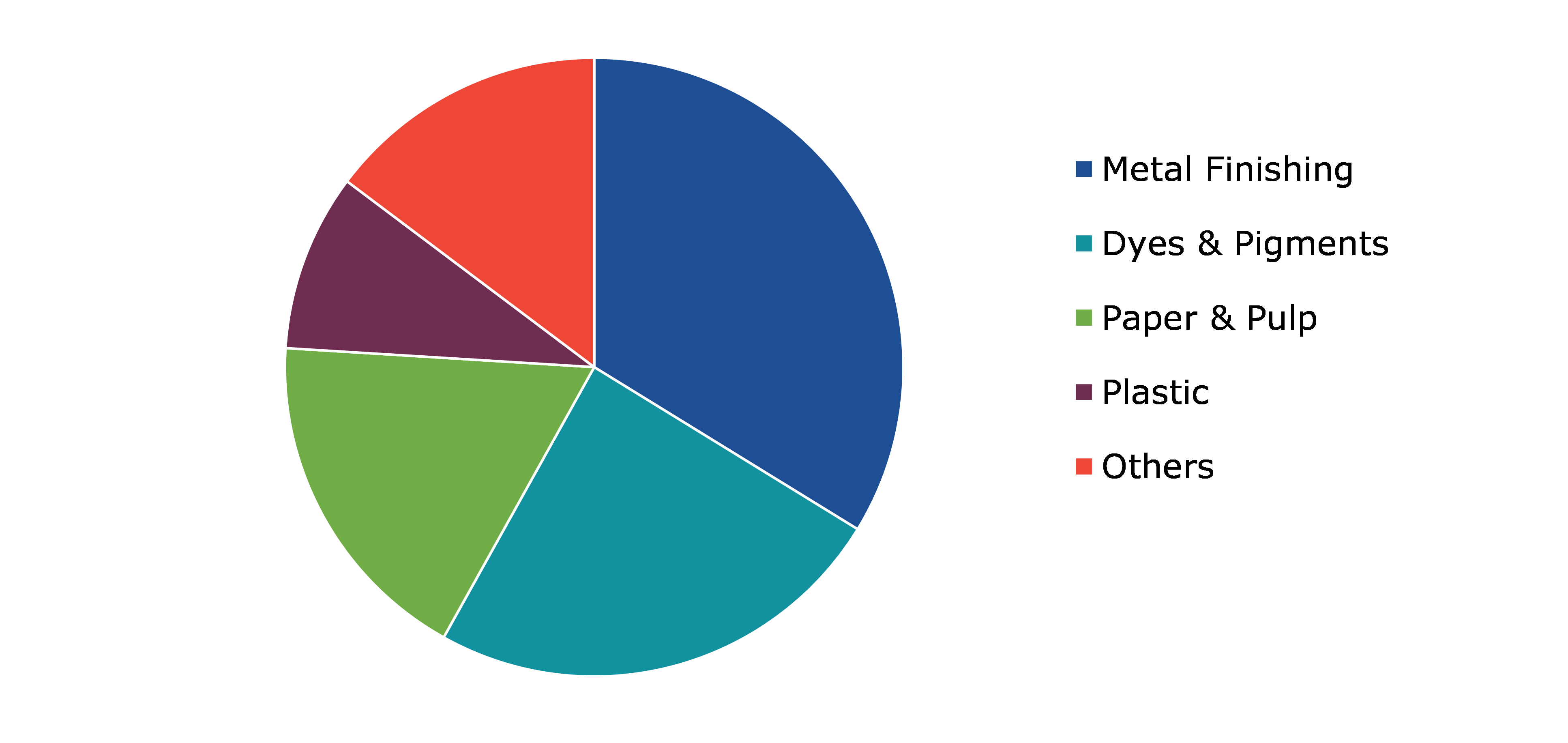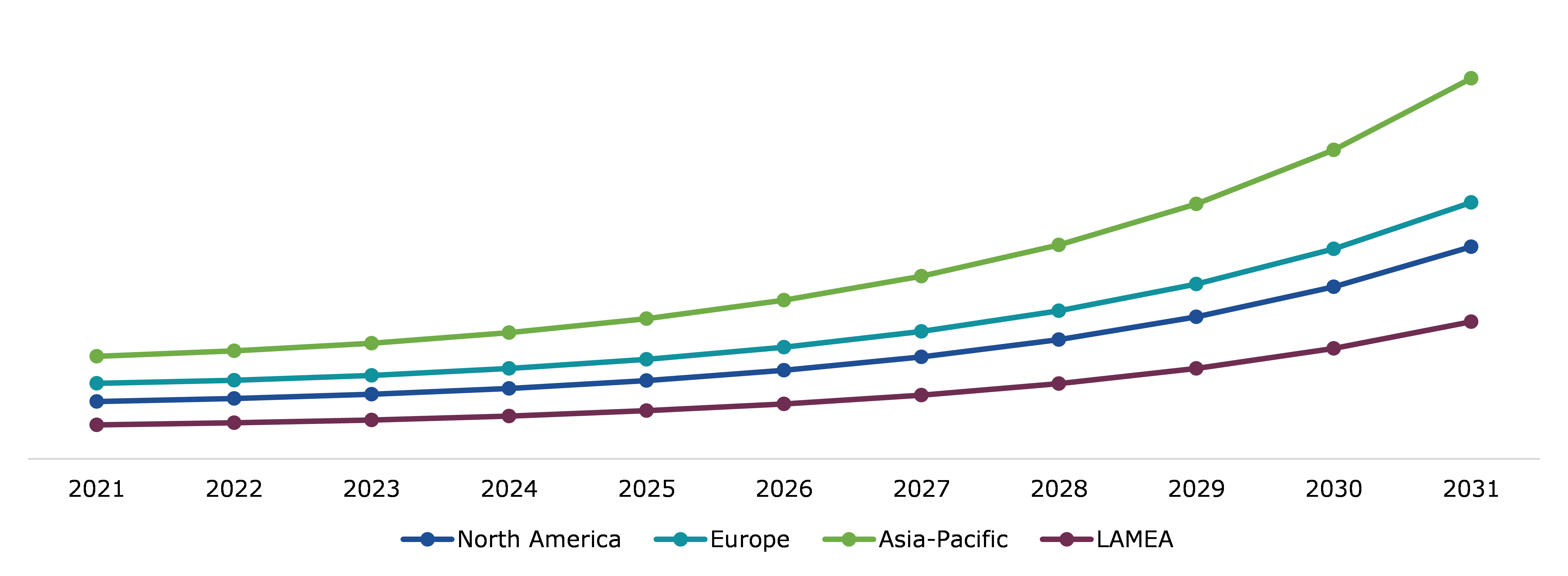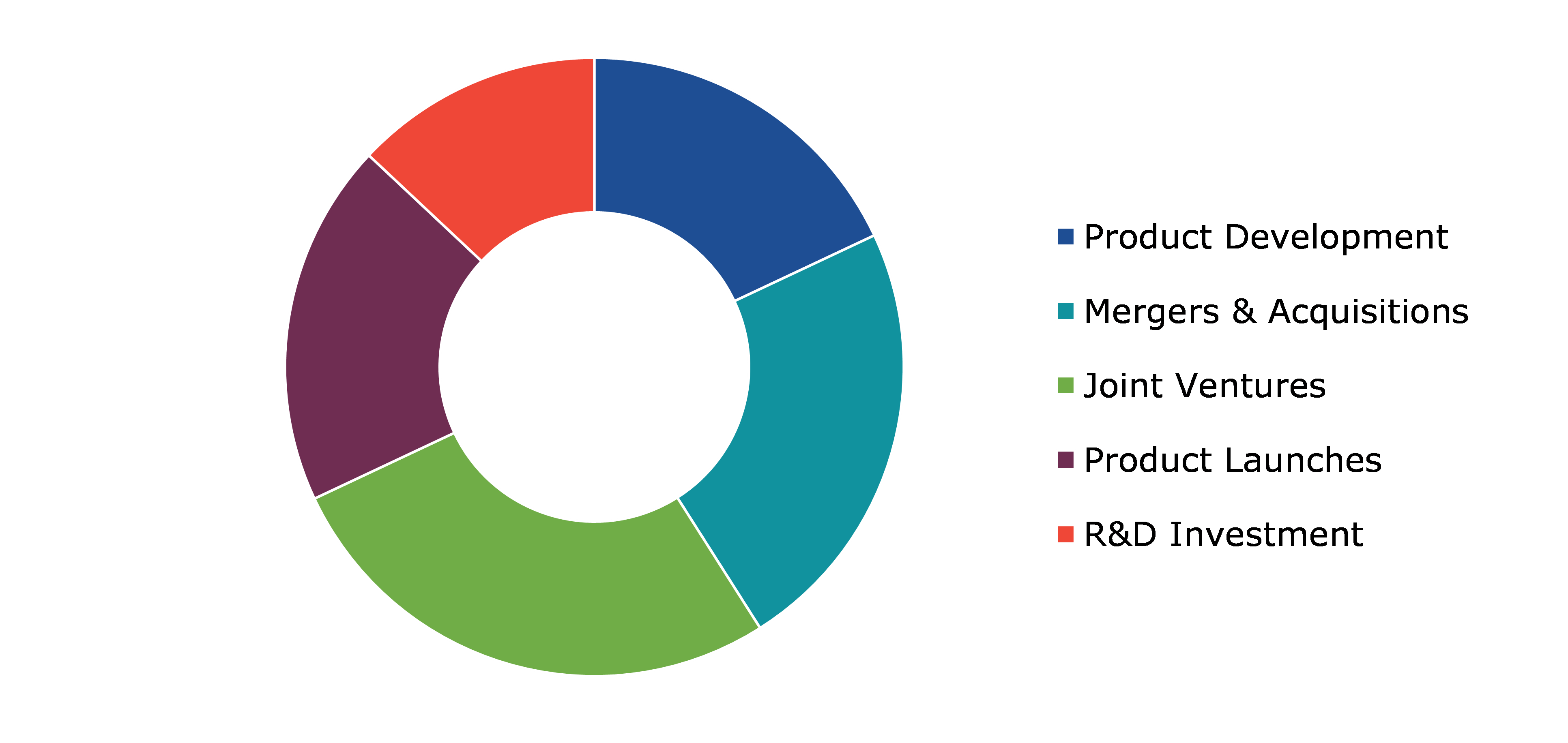Sulfamic Acid Market Report
RA00160
Sulfamic Acid Market by Form (Liquid and Powder), and Application (Metal Finishing, Dyes & Pigments, Paper & Pulp, Plastic, and Others): Global Opportunity Analysis and Industry Forecast, 2022-2031
Global Sulfamic Acid Market Analysis
The global sulfamic acid market size was $375.00 million in 2021 and is predicted to grow with a CAGR of 15.0%, by generating revenue of $1,372.80 million by 2031.
Global Sulfamic Acid Market Synopsis
Sulfamic acid is a molecular compound with the formula H3NSO3. It is also known as amidosulfonic acid, amidosulfuric acid, aminosulfonic acid, sulphamic acid, and sulfamidic acid. The main factors driving the growth of the sulfamic acid market share include high demand for various industrial applications and an increase in demand for personal care products in the market. The tendency to spend on cosmetics is not greatly influenced by a slowdown; rather, consumer choices tend to shift to low-cost market products. The personal care industry is an engaging and promising market, and it is expected to grow in the near future. Therefore, sulfamic acid market demand is expected to rise in the coming years.
However, sulfamic acid is extremely corrosive, thus, when it comes in touch with the skin, it may result in chemical burns and subsequent heat burns. If it comes in touch with the eyes, it can also burn the cornea and make the person blind. All these factors are projected to hamper the sulfamic acid market growth during the forecast period.
An increase in the potential for partnerships and collaborations among the top market participants is brought about by factors such as an increase in population, a rise in hygiene awareness, and an increase in demand for domestic cleaning appliances. In addition, governments of various countries globally are making greater efforts to boost chemical production and the development of chemical industries. Rise in demand for sulfamic acid in the dyeing and textile sectors is anticipated to create new opportunities for the leading businesses and boost the market revenue.
Region-wise, the Asia-Pacific sulfamic acid market accounted for $142.90 million in 2021 and is predicted to grow with a CAGR of 15.0% during the forecast period. This rise is mostly attributable to the increase in the use of cosmetics and the rise in public concern about water purification.
Sulfamic Acid Overview
Sulfamic acid is a white, odorless, crystalline (sand-like) solid. It is used in metal and ceramic cleaning, dye manufacturing, chlorine stabilization in swimming pools, electroplating, and as a bleaching agent. Sulfamic acid is used as an acidic cleaning agent, typically for metals and ceramics. It is a replacement for hydrochloric acid for the removal of rust. In households, it is often found as a descaling agent in detergents, cleaners, and toilet cleaners for the removal of limescale.
COVID-19 Impact on Global Sulfamic Acid Market
Every business and industry was dealing with a variety of unforeseen issues owing to the rapid spread of COVID-19 in different parts of the globe. The economy suffered a severe downturn as a result of lockdowns imposed by governments of various countries. Some companies suffered losses and debt due to the pandemic, but others, such as the healthcare, chemical, and pharmaceutical sectors, incurred profit and witnessed an increase in demand. Sulfamic acid is used to make pesticides and cleaning solutions. During the pandemic, cleaning and hygiene were necessary, and demand for cleaning supplies increased during this time. Hence, the pandemic helped in the expansion of the sulfamic acid market. Furthermore, on the consumer side, the pandemic boosted people's concern for cleanliness and hygiene, which increased the sulfamic acid market demand for toilet cleaning products and detergents.
Rise in Sulfamic Acid Consumption in Paper and Pulp Product Manufacturing to Drive the growth of the Sulfamic Acid Market
Sulfamic acid is a common acidic cleaning solution for metals and ceramics. Hydrochloric acid has been phased out as a rust remover during the past few years in favor of sulfamic acid. It is often used in homes as a descaling agent in detergents and toilet cleansers to remove lime scale. Sulfamic acid possesses necessary low toxicity, low volatility, and water descaling qualities as compared to other strong and popular strong mineral acids. It creates calcium and ferric iron salts that are water soluble. Sulfamic acid is chosen for usage in domestic applications over hydrochloric acid due to its inherent safety. Sulfamic acid, unlike the majority of other acids, does not generate chlorine gas when improperly combined with items containing hypochlorite. In addition, sulfamic acid is a potent and secure acid that works well for acid cleaning and descaling applications. Descaling heating coils and heated containers in food handling facilities is one of the most popular uses of sulfamic acid due to its ability to quickly remove hardness deposits without producing unpleasant aromas or fumes. Sulfamic acid is therefore regarded as the most widely used, secure, and desired acid in a variety of sectors.
To know more about global sulfamic acid market drivers, get in touch with our analysts here.
Sulfamic Acid’s Dangerous Effects on Health to Restrain the Market Growth
One of the main factors limiting the growth of the global sulfamic acid market revenue is the high danger of chemical burns to the skin and secondary thermal burns caused by sulfamic acid's corrosiveness. The sulfamic acid manufacturing industry can risk the workers as it can result in blindness, tissue burns, nose and lung burns from inhaling sulfamic acid fumes, and other harmful effects. In addition, the COVID-19 pandemic and the shutdown of manufacturing facilities due to lockdown are anticipated to significantly impede the market revenue growth during the forecast period. All these factors are projected to hinder the sulfamic acid market growth in the coming years.
Increase in Production and Use of Sulfamic Acid to Create Opportunities in the Sulfamic Acid Market
Sulfamic acid is used in several industries, which is expected to increase its demand globally in the years to come. Sulfamic acid also has various functions, such as an herbicide, a coagulator for urea-formaldehyde resins, a component of a fire extinguishing medium, and a catalyst for the esterification process. For instance, in 2021, Lautan Sulfamat Lestari, a subsidiary of Lautan Luas in Indonesia, created a plan to build a 7,000 tons per year sulfamic acid facility close to Jakarta. Technical grade sulfamic acid is being produced more frequently by an ISO-certified company in India called Vishnupriya Chemicals to replace the corrosion inhibitors used for chlorine stabilization. The Milliken, chemical company must obtain ISO and Food Drug Association clearance before establishing a sulfamic acid factory. A firm based in chemicals, Milliken, intends to work with chemists to introduce advances in equipment services to flourish in the sulfamic assistance industry. All these factors are projected to create several growth opportunities for key players operating in the market.
To know more about global sulfamic acid market opportunities, get in touch with our analysts here.
Global Sulfamic Acid Market, by Form
By form, the market is divided into liquid and powder. Among these, the powder segment accounted for the highest market share in 2021, whereas the liquid segment is estimated to show the fastest growth during the forecast period.
Global Sulfamic Acid Market Growth, by Form, 2021
Source: Research Dive Analysis
The powder segment accounted for a dominant market share in 2021. As a substitute for hydrochloric acid, sulfamic acid powder is becoming more in demand as an acidic cleaning agent for metals and ceramics. In addition, sulfamic acid powder is used in detergents and toilet cleansers to remove lime scale and other debris from domestic appliances, flooring, tiles, and others. This factor is projected to boost the growth of the powder segment of the sulfamic acid market.
The liquid segment is anticipated to show the fastest growth by 2031. Furthermore, sulfamic acid is sometimes used alone or in combination with other products as an acidic cleaning agent, usually for metals and ceramics. It is widely employed to get rid of limescale and rust.
Global Sulfamic Acid Market by Application
By application, the market is divided into metal finishing, dyes & pigments, paper & pulp, plastic, and others. Among these, the metal finishing segment accounted for the highest revenue share in 2021.
Global Sulfamic Acid Market Outlook, by Application, 2021
Source: Research Dive Analysis
The metal finishing segment accounted for a dominant market share in 2021. Sulfamic acid is a highly effective descaling product that is used to clean a wide range of industrial goods. It aids in the removal of beer and milk stone, protein buildup, beer scale, light rust, and copper corrosion. These factors are anticipated to boost the growth of the metal finishing segment during the forecast period.
Global Sulfamic Acid Market, Regional Insights
The sulfamic acid market is analyzed across North America, Europe, Asia-Pacific, and LAMEA.
Global Sulfamic Acid Market Size & Forecast, by Region, 2021-2031 ($Million)
Source: Research Dive Analysis
The Market for Sulfamic Acid in Asia-Pacific to be the Most Dominant
Sulfamic acid demand is also developing quickly as a result of new advances in a variety of sectors, including the chemical and textile industries. For instance, China's growing chemical industry is anticipated to drive the regional market revenue growth. Other factors anticipated to contribute to the market revenue growth during the forecast period include technological advancements in end-use industries such as the pharmaceutical and food & beverage industries. Furthermore, sulfamic acid sales are likely to be dominated by China and India in Asia-Pacific during the forecast period as China has a large number of medium-sized businesses and accounts for the majority of global demand. Sulfamic acid is increasingly in demand in India due to its use in pigment, plastics, medicines, and paper packaging.
Competitive Scenario in Global Sulfamic Acid Market
Investment and agreement are common strategies followed by major market players. For instance, on July 27, 2021, the introduction of innovative, cutting-edge machinery and technology for the production of sulfamic acid and the creation and marketing of productswere announced by Tangshan Sanding Chemical Co., Ltd.
Source: Research Dive Analysis
Some of the leading sulfamic acid market players are Nissan Chemical, Mingda Chemical, BASF SE, AkzoNobel N.V., DuPont, Jiangsu Yazhong, Palm Commodities, Yantai Sanding, Raviraj Group, and Shree Sulphamic Chemicals.
| Aspect | Particulars |
| Historical Market Estimations | 2020 |
| Base Year for Market Estimation | 2021 |
| Forecast Timeline for Market Projection | 2022-2031 |
| Geographical Scope | North America, Europe, Asia-Pacific, and LAMEA |
| Segmentation by Form |
|
| Segmentation by Application |
|
| Key Companies Profiled |
|
Q1. What is the size of the global sulfamic acid market?
A. The size of the global sulfamic acid market was over $375.00 million in 2021 and is projected to reach $1,372.80 million by 2031.
Q2. Which are the major companies in the sulfamic acid market?
A. Mingda Chemical, BASF SE, and AkzoNobel N.V. are some of the key players in the global sulfamic acid market.
Q3. Which region, among others, possesses greater investment opportunities in the near future?
A. Asia-Pacific possesses great investment opportunities for investors in the future.
Q4. What will be the growth rate of the Asia-Pacific sulfamic acid market?
A. The Asia-Pacific sulfamic acid market is anticipated to grow at 15.0% CAGR during the forecast period.
Q5. What are the strategies opted by the leading players in this market?
A. Agreement and investment are the two key strategies opted by the operating companies in this market.
Q6. Which companies are investing more on R&D practices?
A. BASF SE, AkzoNobel N.V., and DuPont are investing more in R&D activities for developing new products and technologies.
1.Research Methodology
1.1.Desk Research
1.2.Real time insights and validation
1.3.Forecast model
1.4.Assumptions and forecast parameters
1.5.Market size estimation
1.5.1.Top-down approach
1.5.2.Bottom-up approach
2.Report Scope
2.1.Market definition
2.2.Key objectives of the study
2.3.Report overview
2.4.Market segmentation
2.5.Overview of the impact of COVID-19 on Global Sulfamic Acid market
3.Executive Summary
4.Market Overview
4.1.Introduction
4.2.Growth impact forces
4.2.1.Drivers
4.2.2.Restraints
4.2.3.Opportunities
4.3.Market value chain analysis
4.3.1.List of raw material suppliers
4.3.2.List of manufacturers
4.3.3.List of distributors
4.4.Innovation & sustainability matrices
4.4.1.Technology matrix
4.4.2.Regulatory matrix
4.5.Porter’s five forces analysis
4.5.1.Bargaining power of suppliers
4.5.2.Bargaining power of consumers
4.5.3.Threat of substitutes
4.5.4.Threat of new entrants
4.5.5.Competitive rivalry intensity
4.6.PESTLE analysis
4.6.1.Political
4.6.2.Economical
4.6.3.Social
4.6.4.Technological
4.6.5.Environmental
4.7.Impact of COVID-19 on Sulfamic Acid market
4.7.1.Pre-covid market scenario
4.7.2.Post-covid market scenario
5.Sulfamic Acid Market Analysis, by Form
5.1.Overview
5.2.Powder
5.2.1.Definition, key trends, growth factors, and opportunities
5.2.2.Market size analysis, by region, 2021-2031
5.2.3.Market share analysis, by country, 2021-2031
5.3. Liquid
5.3.1.Definition, key trends, growth factors, and opportunities
5.3.2.Market size analysis, by region, 2021-2031
5.3.3.Market share analysis, by country, 2021-2031
5.4.Research Dive Exclusive Insights
5.4.1.Market attractiveness
5.4.2.Competition heatmap
6.Sulfamic Acid Market Analysis, by Application
6.1.Metal Finishing
6.1.1.Definition, key trends, growth factors, and opportunities
6.1.2.Market size analysis, by region, 2021-2031
6.1.3.Market share analysis, by country, 2021-2031
6.2.Dyes & Pigments
6.2.1.Definition, key trends, growth factors, and opportunities
6.2.2.Market size analysis, by region, 2021-2031
6.2.3.Market share analysis, by country, 2021-2031
6.3.Paper & Pulp
6.3.1.Definition, key trends, growth factors, and opportunities
6.3.2.Market size analysis, by region, 2021-2031
6.3.3.Market share analysis, by country, 2021-2031
6.4.Plastic
6.4.1.Definition, key trends, growth factors, and opportunities
6.4.2.Market size analysis, by region, 2021-2031
6.4.3.Market share analysis, by country, 2021-2031
6.5.Others
6.5.1.Definition, key trends, growth factors, and opportunities
6.5.2.Market size analysis, by region, 2021-2031
6.5.3.Market share analysis, by country, 2021-2031
6.6.Research Dive Exclusive Insights
6.6.1.Market attractiveness
6.6.2.Competition heatmap
7.Sulfamic Acid Market, by Region
7.1.North America
7.1.1.U.S.
7.1.1.1.Market size analysis, by Form, 2021-2031
7.1.1.2.Market size analysis, by Application, 2021-2031
7.1.2.Canada
7.1.2.1.Market size analysis, by Form, 2021-2031
7.1.2.2.Market size analysis, by Application, 2021-2031
7.1.3.Mexico
7.1.3.1.Market size analysis, by Form, 2021-2031
7.1.3.2.Market size analysis, by Application, 2021-2031
7.1.4.Research Dive Exclusive Insights
7.1.4.1.Market attractiveness
7.1.4.2.Competition heatmap
7.2.Europe
7.2.1.Germany
7.2.1.1.Market size analysis, by Form, 2021-2031
7.2.1.2.Market size analysis, by Application, 2021-2031
7.2.2.UK
7.2.2.1.Market size analysis, by Form 2021-2031
7.2.2.2.Market size analysis, by Application, 2021-2031
7.2.3.France
7.2.3.1.Market size analysis, by Form, 2021-2031
7.2.3.2.Market size analysis, by Application, 2021-2031
7.2.4.Spain
7.2.4.1.Market size analysis, by Form, 2021-2031
7.2.4.2.Market size analysis, by Application, 2021-2031
7.2.5.Italy
7.2.5.1.Market size analysis, by Form, 2021-2031
7.2.5.2.Market size analysis, by Application, 2021-2031
7.2.6.Rest of Europe
7.2.6.1.Market size analysis, by Form, 2021-2031
7.2.6.2.Market size analysis, by Application, 2021-2031
7.2.7.Research Dive Exclusive Insights
7.2.7.1.Market attractiveness
7.2.7.2.Competition heatmap
7.3.Asia-Pacific
7.3.1.China
7.3.1.1.Market size analysis, by Form 2021-2031
7.3.1.2.Market size analysis, by Application, 2021-2031
7.3.2.Japan
7.3.2.1.Market size analysis, by Form, 2021-2031
7.3.2.2.Market size analysis, by Application, 2021-2031
7.3.3.India
7.3.3.1.Market size analysis, by Form, 2021-2031
7.3.3.2.Market size analysis, by Application, 2021-2031
7.3.4.Australia
7.3.4.1.Market size analysis, by Form, 2021-2031
7.3.4.2.Market size analysis, by Application, 2021-2031
7.3.5.South Korea
7.3.5.1.Market size analysis, by Form, 2021-2031
7.3.5.2.Market size analysis, by Application, 2021-2031
7.3.6.Rest of Asia-Pacific
7.3.6.1.Market size analysis, by Form, 2021-2031
7.3.6.2.Market size analysis, by Application, 2021-2031
7.3.7.Research Dive Exclusive Insights
7.3.7.1.Market attractiveness
7.3.7.2.Competition heatmap
7.4.LAMEA
7.4.1.Brazil
7.4.1.1.Market size analysis, by Form, 2021-2031
7.4.1.2.Market size analysis, by Application, 2021-2031
7.4.2.Saudi Arabia
7.4.2.1.Market size analysis, by Form, 2021-2031
7.4.2.2.Market size analysis, by Application, 2021-2031
7.4.3.UAE
7.4.3.1.Market size analysis, by Form, 2021-2031
7.4.3.2.Market size analysis, by Application, 2021-2031
7.4.4.South Africa
7.4.4.1.Market size analysis, by Form, 2021-2031
7.4.4.2.Market size analysis, by Application, 2021-2031
7.4.5.Rest of LAMEA
7.4.5.1.Market size analysis, by Form, 2021-2031
7.4.5.2.Market size analysis, by Application, 2021-2031
7.4.6.Research Dive Exclusive Insights
7.4.6.1.Market attractiveness
7.4.6.2.Competition heatmap
8.Competitive Landscape
8.1.Top winning strategies, 2021
8.1.1.By strategy
8.1.2.By year
8.2.Strategic overview
8.3.Market share analysis, 2021
9.Company Profiles
9.1.Nissan Chemical
9.1.1.Overview
9.1.2.Business segments
9.1.3.Product portfolio
9.1.4.Financial performance
9.1.5.Recent developments
9.1.6.SWOT analysis
9.2.Mingda Chemical
9.2.1.Overview
9.2.2.Business segments
9.2.3.Product portfolio
9.2.4.Financial performance
9.2.5.Recent developments
9.2.6.SWOT analysis
9.3.BASF SE
9.3.1.Overview
9.3.2.Business segments
9.3.3.Product portfolio
9.3.4.Financial performance
9.3.5.Recent developments
9.3.6.SWOT analysis
9.4.AkzoNobel N.V.
9.4.1.Overview
9.4.2.Business segments
9.4.3.Product portfolio
9.4.4.Financial performance
9.4.5.Recent developments
9.4.6.SWOT analysis
9.5.DuPont
9.5.1.Overview
9.5.2.Business segments
9.5.3.Product portfolio
9.5.4.Financial performance
9.5.5.Recent developments
9.5.6.SWOT analysis
9.6.Jiangsu Yazhong
9.6.1.Overview
9.6.2.Business segments
9.6.3.Product portfolio
9.6.4.Financial performance
9.6.5.Recent developments
9.6.6.SWOT analysis
9.7.Palm Commodities
9.7.1.Overview
9.7.2.Business segments
9.7.3.Product portfolio
9.7.4.Financial performance
9.7.5.Recent developments
9.7.6.SWOT analysis
9.8.Yantai Sanding
9.8.1.Overview
9.8.2.Business segments
9.8.3.Product portfolio
9.8.4.Financial performance
9.8.5.Recent developments
9.8.6.SWOT analysis
9.9.Raviraj Group
9.9.1.Overview
9.9.2.Business segments
9.9.3.Product portfolio
9.9.4.Financial performance
9.9.5.Recent developments
9.9.6.SWOT analysis
9.10.Shree Sulphamic Chemicals
9.10.1.Overview
9.10.2.Business segments
9.10.3.Product portfolio
9.10.4.Financial performance
9.10.5.Recent developments
9.10.6.SWOT analysis
10.Appendix
10.1.Parent & peer market analysis
10.2.Premium insights from industry experts
10.3.Related reports
Synthetic organic reactions have recently acquired prominence as a versatile tool in the synthesis of agrochemicals, medicines, and their intermediates. Sulfamic acid, a very effective heterogeneous solid acid catalyst, catalyzes a variety of organic reactions. Tremendous efforts have been made by several researchers to use sulfamic acid as a green catalyst for functional group transformations, C−C bond formation reactions, preparations of N- and O− containing heterocyclic compounds, and various reactions including multicomponent reactions.
Sulfamic acid, also known as sulfamidic acid or amino sulfonic acid, is the most basic form of sulfamic acid, consisting of a sulphur atom covalently connected in single bonds with amino and hydroxyl groups, as well as a double bond with two oxygen atoms. Sulfamic acid is less corrosive to metals than other powerful acids such as hydrochloric acid. Properties such as low corrosiveness, high stability, high melting point, and high-water solubility, among others have extended applications of sulfamic acid in numerous industries. The global sulfamic acid market is expanding at a rapid pace and is growing swiftly owing to the usage of sulfamic acid as a soothing agent and its increasing need in the leather and plastic coloring industries.
Newest Insights in the Sulfamic Acid Market
The growing need for ready-to-eat food, packed, and dairy products and increasing expansions in packaging industries are some factors contributing to revenue growth of the global sulfamic acid market. As per a report by Research Dive, the global sulfamic acid market is expected to surpass a revenue of $1,372.80 million in the 2022-2031 timeframe. The Asia-Pacific region is expected to perceive foremost and leading growth in the coming years. This is because of the rising use of sulfamic acid in the production of therapeutic agents like antibiotics, anti-epileptic drugs, proteases, and a variety of inhibitory drugs in the region.
How are Market Players Retorting to the Rising Demand for Sulfamic Acid?
Market players are significantly investing in ground-breaking research and inventions to cater to the increasing demand for sulfamic acid in paper and pulp product manufacturing. Some of the foremost players in the sulfamic acid market are Mingda Chemical, Nissan Chemical, AkzoNobel N.V., BASF SE, Jiangsu Yazhong, DuPont, Yantai Sanding, Palm Commodities, Shree Sulphamic Chemicals, Raviraj Group, and others. These players are implementing strategies such as collaborations, innovative advances, mergers and acquisitions, and partnerships to reach a noteworthy position in the global market.
For instance, in July 2021, Tangshan Sanding Chemical Co., Ltd., established by Japan Hakuei Corporation, announced the launch of new equipment and advanced technology for the production of sulfamic acid and the sale and development of products. Furthermore, the company announced an environmental acceptance report for the project's completion with an output of 2,000 tonnes of ammonium sulfamate.
COVID-19 Impact on the Global Sulfamic Acid Market
The unpredicted rise of the coronavirus pandemic in 2020 has positively impacted the global sulfamic acid market. During the pandemic period, lockdowns enforced by governments of numerous nations caused a significant slowdown in the economy. The pandemic resulted in losses and debt for some businesses, but it also increased demand and generated profits for others, including those in the chemical, pharmaceutical, and healthcare industries. During the pandemic, sulfamic acid has been greatly utilized to make cleaning solutions and pesticides. Hygiene and cleaning were essential during the epidemic, and there was an increase in the need for cleaning products at this time. As a result, the pandemic significantly contributed to the growth of the sulfamic acid market.
Personalize this research
- Triangulate with your own data
- Request your format and definition
- Get a deeper dive on a specific application, geography, customer or competitor
- + 1-888-961-4454 Toll - Free
- support@researchdive.com

